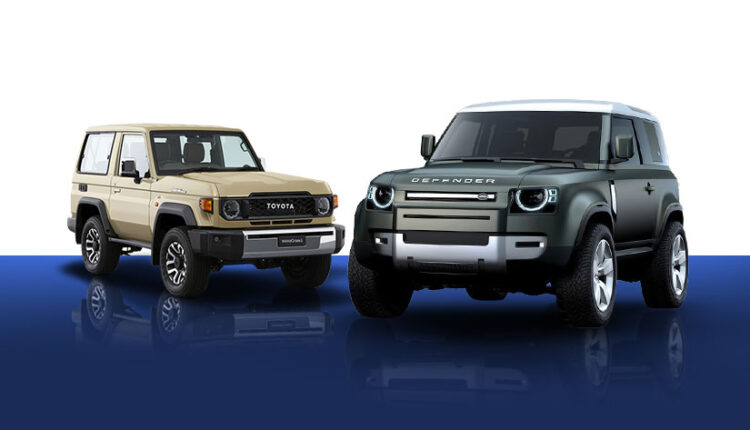Land Rover Defender vs. Land Cruiser J70 | Off-road Champion and Luxury Beast!
Land Cruiser J70, the OG long-living SUV king, Australians’ favorite, and probably Toyota’s toughest rugged proper 4×4 SUV, has just one purpose: to do off-roading. Unlike modern SUVs that put hybrid motors and tiny engines under the monocoque chassis, this J70 is what you call an SUV.
On the other hand, we have the Land Rover Defender. Both are ironically different and have different stereotype cults, but both are known as SUV off-roaders and compete under the same price tag.
Defender is more towards the luxury side than an off-roader and probably not the first choice of Australians; it is a car made for Europeans and British.
Let’s just do 1-1 of both cars and see which did the best:
Toyota Land Cruiser J70

Land Cruiser J70, Toyota’s iconic and extraordinarily popular off-roader SUV, although not very modern, uses the same design as we used to see in the 1970 J70, but that’s how it’s designed. If you compare it with today’s modern car, it doesn’t stack with them in any way, but still, people are willing to pay 169,000 AED for this SUV.
You see, it’s a simple 4.8-liter diesel turbo-engine SUV—nothing fancy. It uses a ladder frame and leaf spring suspensions, and of course, it has a Toyota badge on it, which is its main selling point.
Mostly, in UAE, it’s bought by commercial consumers like Desert Safari agencies, construction, and work truck companies, or any other consumers who need a rugged car for deserts and off-roading. They don’t need any fancy items, just a vehicle that lasts an eternity and can face extreme conditions, and that’s why the J70 is still surviving in UAE; even buyers who want this car are willing to pay 169,000 AED.
Land Rover Defender

Defender that’s the most British SUV you’ll ever see. They call it an off-roader, but we think it’s a European off-roader and might not work well for UAE’s extreme deserts. It’s more like a luxury family SUV with some thrills of off-roading.
Unlike the J70, which is simple and super rugged, the Defender is the complete opposite. You name every hi-tech luxury feature, and Defender has it! Unlike J70, it also got super smooth drive quality and due to its SUV body, you can fit a full-size family in it and do long tours without a fuss.
It’s a 3-liter V6 engine that is more efficient than Toyota’s 4.8-liter V8 because it outputs 264 HP, while Toyota’s V8 only outputs 89 HP. This is mainly because Toyota is a low-stress engine, and so it lasts an eternity (800,000 km, no fuss).
Here’s the table version comparison of both cars:
Specification |
Land Rover Defender |
Toyota Land Cruiser 70 Series |
Interior |
||
| Seating | Grained leather and Robust Woven Textile seats | Vinyl seats in WorkMate; fabric seats with carpet flooring in GXL |
| 12-way heated, electric memory front seats with 2-way manual headrests | ||
| Infotainment | 10″ Pivi Pro touchscreen with Interactive Driver Display | 6.1″ touchscreen with satellite navigation |
| Meridian™ 400W sound system with 10 speakers and subwoofer | 2-speaker audio system in WorkMate; 4 speakers in Wagon | |
| Additional Features | ClearSight interior rearview mirror | Air conditioning |
| Heated steering wheel | Power windows in GXL | |
| Front center console refrigerator compartment | Central locking in GXL | |
| Domestic plug socket | ||
Exterior |
||
| Wheels | 20″ Style 5098, 5-spoke, Gloss Sparkle Silver wheels | 16″ steel wheels in WorkMate |
| Alloy wheels in GXL | ||
| Lighting | Matrix LED headlights with signature DRL | LED headlamps |
| Front fog lights | Daytime running lights | |
| Auto high beam assist | Front fog lights in GXL | |
| Roof | Contrast roof options | Standard body-color roof |
| Sliding panoramic roof; folding fabric roof | ||
Safety |
||
| Driver Assistance | 3D Surround Camera | Toyota Safety Sense |
| Blind Spot Assist | Includes Lane Departure Alert, | |
| Rear Traffic Monitor | Pre-Collision Safety System | |
| Lane Keep Assist | Road Sign Assist | |
| Emergency Braking | ABS | |
| Traffic Sign Recognition and Adaptive Speed Limiter | ||
| Wade Sensing | ||
| Structural Safety | Electronic Air Suspension with Adaptive Dynamics | Rigid frame |
| Rigid body architecture | Side intrusion beams | |
| Collapsible steering column | ||
Performance |
||
| Drive System | All-Wheel Drive | 4WD with Active Traction Control |
| Terrain Response 2 with Configurable Terrain Response | ||
| Engine Options | 2.0L P300 i4 Gasoline | 4.5L V8 turbo-diesel |
| 3.0L P400 i6 MHEV | 2.8L 4-cylinder turbo-diesel | |
| 5.0L P525 V8 Gasoline | ||
| Transmission | 8-speed automatic transmission | 5-speed manual in V8 |
| 6-speed automatic in 4-cylinder | ||
| Power Output | Up to 525 hp (P525 V8) | 151 kW (202 hp) in V8 |
| 150 kW (201 hp) in 4-cylinder | ||
| Torque | Up to 625 Nm (P525 V8) | 430 Nm in V8 |
| 500 Nm in 4-cylinder | ||
| Towing Capacity | Up to 3,500 kg | 3,500 kg |
| Additional Features | Heated windscreen | Front and rear differential locks in GXL |
| Configurable Terrain Response | Optional accessories like steel bull bar | |
| Optional Off-Road Pack | Winch and tow bar |
Let us know what you think about these two cars, and keep following the Arabwheels blog for more future comparisons.

